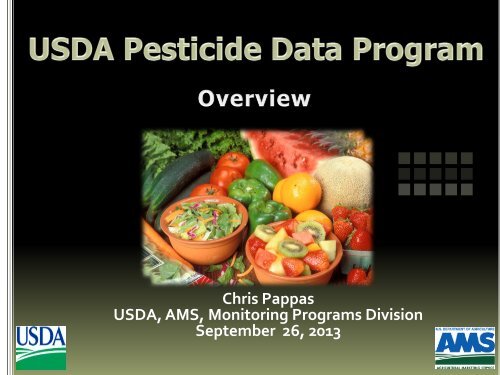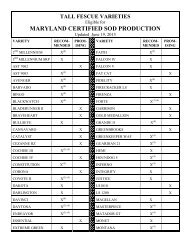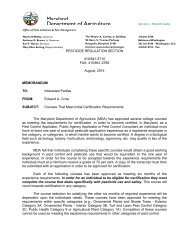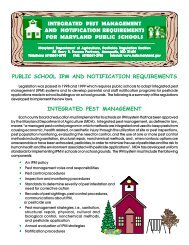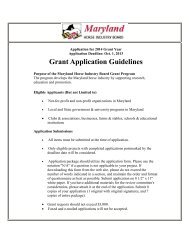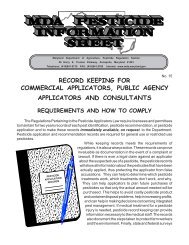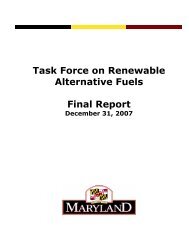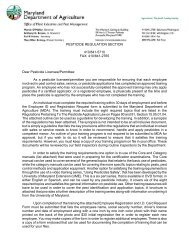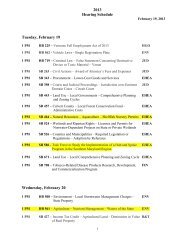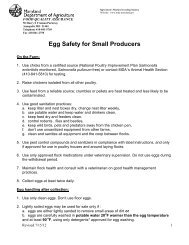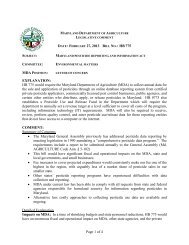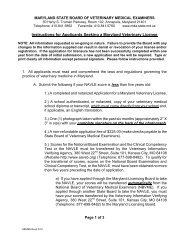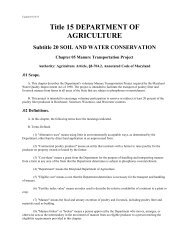USDA Pesticide Data Program - Maryland Department of Agriculture
USDA Pesticide Data Program - Maryland Department of Agriculture
USDA Pesticide Data Program - Maryland Department of Agriculture
Create successful ePaper yourself
Turn your PDF publications into a flip-book with our unique Google optimized e-Paper software.
Chris Pappas<br />
<strong>USDA</strong>, AMS, Monitoring <strong>Program</strong>s Division<br />
September 26, 2013
Provide data for dietary risk<br />
assessments and pesticide<br />
reregistration decisions to the<br />
Environmental Protection Agency<br />
(EPA)<br />
Support marketing <strong>of</strong> U.S.<br />
commodities<br />
Support <strong>USDA</strong> responsibility under<br />
the Food Quality Protection Act <strong>of</strong><br />
1996<br />
Provide information to the Food and<br />
Drug Administration on violations
Ensure that pesticide residues in food do<br />
not cause harm to humans and the<br />
environment<br />
Provides additional safety factor to<br />
protect children from pesticides<br />
Older pesticides have been replaced with<br />
“reduced risk pesticides”
13,000-15,000 samples tested<br />
annually<br />
To date, 102 commodities<br />
sampled and tested<br />
Commodities in program for up<br />
to 2 years<br />
Rotation <strong>of</strong> high consumption<br />
items every 5 years<br />
New commodities based on<br />
data needs<br />
Sampling rates/timeframes<br />
adjusted to reflect seasonality<br />
Special surveys
Washington<br />
Michigan<br />
Vermont<br />
California<br />
Nevada<br />
Idaho<br />
Wyoming<br />
Colorado<br />
Missouri<br />
Ohio<br />
Massachusetts<br />
Connecticut<br />
New Jersey<br />
Delaware<br />
<strong>Maryland</strong><br />
New<br />
Mexico<br />
Oklahoma<br />
North<br />
Carolina<br />
Texas<br />
Florida<br />
Alaska<br />
Hawaii<br />
Location <strong>of</strong> participating<br />
State (black stars) and<br />
Federal (red stars)<br />
Laboratories<br />
States participating in PDP<br />
States where produce is directly<br />
marketed from participating States<br />
Testing Services Only
Represent U.S. population and therefore<br />
reflect consumption<br />
Represents all U.S. census regions<br />
Includes major fruit and vegetable<br />
production States<br />
Includes domestic and imported foods<br />
Samples collected within hours <strong>of</strong><br />
reaching consumers - represent pesticide<br />
degradation in storage and transit
Reliable laboratory results begin with and<br />
depend directly on the quality and timing <strong>of</strong><br />
sample collection<br />
Samples ready for shipment
PDP: Obtain statistically defensible representation <strong>of</strong> U.S. food<br />
supply so that PDP data reflect actual pesticide residue<br />
exposure from food<br />
<br />
<br />
<br />
<br />
<br />
Rigorous statistical design<br />
Random sampling<br />
Reflects what is typically<br />
available to consumer<br />
Sample collectors are trained in<br />
collection techniques<br />
Special surveys to capture<br />
imports or regional data
59 samples/commodity/month for fresh; 63 for most<br />
processed (NC collects 4 samples/month for 4 commodities)<br />
Sample information captured via handheld or laptop<br />
computers by inspectors on-site<br />
Fruit and vegetable sites at major food distribution centers<br />
and terminal markets<br />
Number <strong>of</strong> samples collected is apportioned according to<br />
population:<br />
California 13 N. Carolina 4<br />
Colorado 2 Ohio 6<br />
Florida 7 Texas 8<br />
<strong>Maryland</strong> 4 Washington 4<br />
Michigan 6<br />
New York 9
12,264<br />
12,899<br />
12,316<br />
13,208<br />
14,749<br />
Samples<br />
13,658<br />
12,689<br />
13,381<br />
13,244<br />
12,845<br />
12,737<br />
12,546<br />
2001<br />
2002<br />
2003<br />
2004<br />
2005<br />
2006<br />
Year<br />
2007<br />
2008<br />
2009<br />
2010<br />
2011<br />
2012
Fruit and Vegetables<br />
• Fresh: > 50 high consumption fruit and vegetables tested on<br />
an ongoing basis<br />
• Processed: juice, canned products, paste, sauces, baby<br />
foods, etc.<br />
Grains:<br />
• Barley, corn, oats, rice, soybeans, wheat<br />
Nuts and Nut Products<br />
• Almonds, peanut butter<br />
Milk and Dairy Products<br />
• Butter, heavy cream, milk<br />
Meat, Poultry, Fish:<br />
• Beef, poultry, pork, catfish<br />
Other: Water, honey, eggs, corn syrup
Apple Juice<br />
Baby food<br />
• Applesauce<br />
• Peas<br />
Bananas<br />
Broccoli<br />
Butter<br />
Carrots<br />
Cauliflower<br />
Celery<br />
Grape Juice<br />
Green Beans<br />
Infant Formula<br />
• Dairy-based<br />
• Soy-based<br />
Mushrooms<br />
Nectarines<br />
Peaches<br />
Plums<br />
Raspberries<br />
Salmon<br />
Squash<br />
• Summer Squash<br />
• Winter Squash<br />
Wheat<br />
Groundwater<br />
Drinking Water
Apple Juice<br />
Avocados<br />
Baby food<br />
• Applesauce<br />
• Carrots<br />
• Peaches<br />
• Peas<br />
Bananas<br />
Butter<br />
Cantaloupe<br />
Cauliflower<br />
Mushrooms<br />
Onions<br />
Orange Juice<br />
Papayas<br />
Peas (snap)<br />
Peppers (sweet bell)<br />
Plums<br />
Squash<br />
• Summer Squash<br />
• Winter Squash<br />
Tangerines<br />
Tomatoes<br />
(cherry/grape)<br />
Wheat<br />
Groundwater<br />
Drinking Water
One or two laboratories<br />
analyze each commodity<br />
Samples prepared<br />
emulating consumer<br />
practices<br />
Lists <strong>of</strong> required<br />
compounds are<br />
commodity-specific<br />
State-<strong>of</strong>-the-art<br />
instrumentation<br />
• GC/MS and GC/MS-MS<br />
• LC/MS and LC/MS-MS<br />
Limits <strong>of</strong> detection (LOD)<br />
are very low (parts-perbillion<br />
for food; parts-pertrillion<br />
for water)
Over 400 pesticides, metabolites, and isomers tested using multiresidue<br />
methods<br />
List is updated as new pesticides are registered<br />
<strong>Pesticide</strong> Classes:<br />
•Carbamates<br />
•Chloroacetanilides (alachlor,<br />
acetochlor, etc.<br />
•Imidazolinones (imazapyr,<br />
imazaquin, etc.)<br />
•Neonicotinyls (acetamiprid,<br />
clothianidin, etc.)<br />
•Organochlorines<br />
•Organophosphates<br />
•Phenoxy acids (2,4,5-T; 2,4-D, etc.)<br />
•Pyrethroids (allethrin, bifenthrin, etc.)<br />
•Strobilurins (azoxystrobin, kresoximmethyl,<br />
etc.)<br />
•Sulfonyl ureas (bensulfuron methyl,<br />
halosulfuron, etc.)<br />
•Triazines (atrazine, simazine, etc.)<br />
•Triazoles (difenoconazole,<br />
hexaconazole, etc.)
Blanks, spikes, and process controls used<br />
with each sample set<br />
Method validation required for each new<br />
commodity and pesticide<br />
Limit <strong>of</strong> detection (LOD) and limit <strong>of</strong><br />
quantitation (LOQ) determined<br />
experimentally at ppb levels (ppt for water)<br />
Participation in National and International<br />
Pr<strong>of</strong>iciency Testing required<br />
International accreditation required (ISO<br />
17025)
RDE is custom-built s<strong>of</strong>tware<br />
RDE electronic Sample Information<br />
Form (e-SIF) System<br />
Web–based RDE System<br />
• Centralized .NET-based s<strong>of</strong>tware<br />
Used by PDP/MDP Labs to enter<br />
and submit complete data sets<br />
Calendar-year data stored in Access<br />
database structure with plans to<br />
migrate to SQL server<br />
Can run ad-hoc queries in MS-<br />
Access in response to data requests
<strong>Pesticide</strong> tolerances evaluated by EPA using PDP<br />
data<br />
<strong>Pesticide</strong> uses reregistered or canceled based on<br />
outcome <strong>of</strong> tolerance evaluations<br />
Examine impact <strong>of</strong> agricultural practices on human<br />
health and the environment<br />
Monitor contaminants in drinking water and<br />
groundwater<br />
Monitor compliance with U.S. EPA tolerances<br />
(MRLs)<br />
Tolerance violations reported to FDA<br />
Verify pesticide usage statistics<br />
Facilitate export <strong>of</strong> U.S. commodities
EPA regulates use <strong>of</strong> pesticides in the U.S.<br />
and establishes tolerances<br />
Tolerances are the maximum quantity <strong>of</strong> a<br />
pesticide residue allowable on a raw<br />
agricultural commodity<br />
FDA enforces EPA tolerances in all foods<br />
except meat and poultry<br />
The <strong>USDA</strong> Food Safety and Inspection<br />
Service is responsible for meat and poultry
PDP Annual Summary<br />
<strong>of</strong> <strong>Data</strong> for years 1992-<br />
2011 are posted on our<br />
Web site:<br />
• www.ams.usda.gov/pdp<br />
Latest data available is<br />
for 2011<br />
2012 data expected in<br />
early 2014
2001 2003 2005 2007 2009 2010 2011<br />
States 10 10 12 12 12 13 12<br />
Crops 22 22 25 23 27 28 25<br />
Analyses 1,024,774 990,372 1,409,605 1,359,676 1,884,212 1,923,734 2,098,808<br />
Labs* 8S 3F 9S 2F 11S 2F 10S 2F 10S 3F 10S 3F 10S 3F<br />
Compounds* 185 331 370 375 400 419 431<br />
*S = State; F = federal. Compounds include parent, metabolites and degradation products.
Previously based on U.S. registrations, Action Levels (ALs),<br />
and MRLs<br />
GAO Audit, EU Apple Audit, EPA’s OIG Audit: need to<br />
expand program to test for foreign uses<br />
Need to identify pesticides used in other countries that<br />
may not have U.S. registrations, but may be present on<br />
foods imported into the U.S.<br />
Have intelligence information <strong>of</strong> illegal pesticides used<br />
overseas – will add these to testing pr<strong>of</strong>iles


